June 05, 2018
2018 Promotional Products Sales Compensation Survey
The ideal sales job candidate – experienced and ready to sell – isn’t materializing, so distributors are getting creative to fill their openings.
For a distributor looking for his pick of sales reps, Joseph Sommer is ostensibly in the right place: New York City.
The industry wunderkind – he’s not yet 30 – owns Brooklyn, NY-based Whitestone Branding (asi/359741), a full-service branded merchandise agency that brought in $2.6 million in 2017 with just a handful of reps.
Don't Miss! 3 Tips On How To Transition To The Promo Industry
The company is located in the largest metropolitan area in the country, with more than 8.5 million inhabitants and 1.6 million daily commuters, according to the U.S. Census. Surely it’s an ideal location for companies seeking to build their sales forces.
For sheer volume of applicants, that’s true. But finding qualified ones who will quickly start making money, as well as meeting their compensation expectations up front, that’s a challenge. Sommer would like sales reps with experience who can come in and hit the ground running. Instead, many of the applicants are green. They want comprehensive training and expect more guarantees.
Sales Rep Compensation
Straight commission is still the predominant form of compensation, but that’s changing. Salary-based compensation (and in particular, straight salary) continues to rise. Older reps are still comfortable with commission pay, but younger reps desire a hybrid method of salary plus commission or bonus or both.
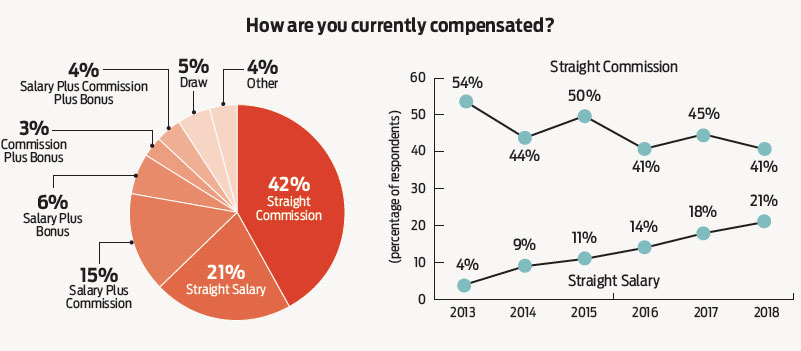
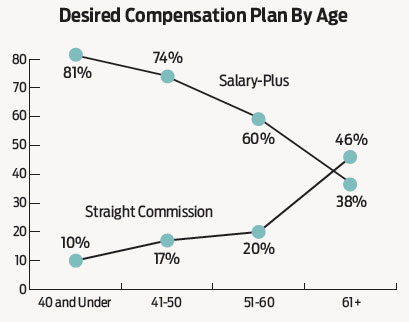
So Sommer got creative: Instead of looking for a sales rep that fits his mold, he looked to a member of his support staff to start selling.
Dominique Volker was first hired as the operations manager to oversee the company’s billing and payment processes as well as product sourcing. At first, the management team had every intention of keeping her in that role. But Sommer recognized two key attributes that would make her a good earner, and it wasn’t a proven sales record: a motivation to make more money, and a can-do attitude.
“She learned the industry first, and then gradually took over my entire book of business so I could start building a new one,” says Sommer. “She’s crushing it.” Last year, Volker brought in $1.3 million.
It’s reinforced Sommer’s philosophy that a well-trained employee who proves him- or herself on the back-end can do well in a client-facing role. In fact, Sommer has immediate plans to bring on another sales assistant who he can gradually move into sales.
“The best way to retain sales reps is to hire people who never meant to go out and sell,” says Sommer. “Then you focus on growing them. We don’t do one-off orders here, so we have to go out and find long-term relationships. The best salespeople aren’t actually salespeople – they’re relationship managers.”
Related: The Sales Path Less Traveled: Dominique Volker, Whitestone Branding
It’s just one example of the way in which companies are finding creative ways to build their sales teams. They’re doing it out of necessity because their ideal candidates – high-performing sales reps who require little training, few benefits and no financial promises beyond straight commission – aren’t showing up at their door.
So where are they? The current employment picture favors employees: overall unemployment is now below 4%, which indicates the U.S. is at full employment. That means there are more openings than qualified hires actually looking for jobs. Meanwhile, those who are looking are savvy and can quickly compare open positions to find exactly what they’re looking for.
In a bid to show up on potential hires’ short lists, companies are offering generous compensation packages, more guarantees (such as salary, benefits and comprehensive training) and fun work environments. That’s music to applicants’ ears, especially since they’re now looking for companies committed to investing in and nurturing them, even before they’re expected to bring in sales.
An added obstacle to hiring is the expense, and applicants’ long list of expectations only jacks up the cost. Stephanie Friedman, the vice president of sales & marketing at City Paper Company (asi/162267) in Birmingham, AL, puts the cost to hire just one rep between $85,000 and $100,000, and that’s before they’re making money. Meanwhile, the hiring process takes at least six to eight weeks. “The onboarding can take months,” she adds.
The cost is a pain point employers often don’t want to address, so they only focus on hiring when they’re desperate to fill positions, which leaves less time to brainstorm and develop new ways to locate and attract talent. But in a competitive sales hiring environment, having a creative strategy is more important than ever.
“You’re always looking for that all-star,” says Jeff Holt, vice president of sales & marketing at Image Source (asi/230121) in Kirkland, WA, “but they don’t grow on trees.”
Pay
Sales rep and manager compensation grew 2% compared to last year, the second year of growth. Of the sales reps who have minimum margins (about four in 10), an increasing number are dropping their limits below 10%, perhaps owing to price pressures.
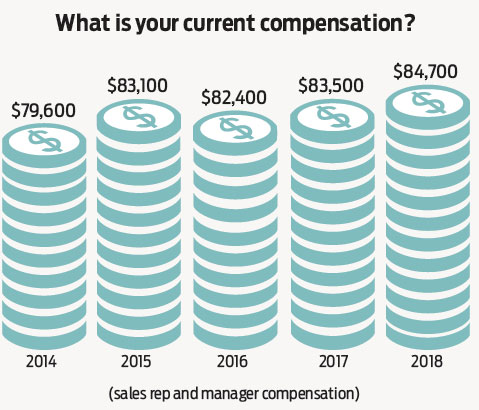
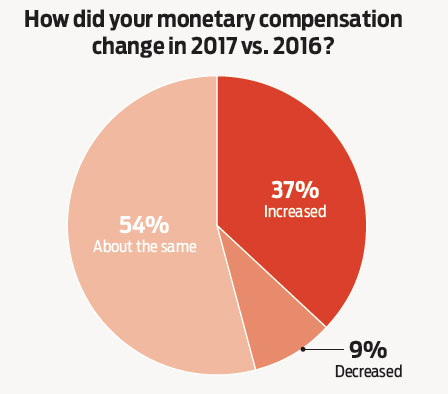
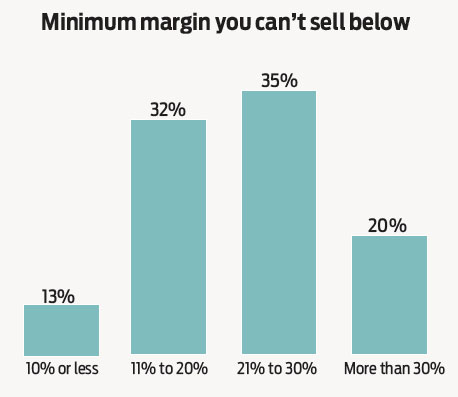
CHALLENGE: The Search
When Chris Carlson graduated college in the early 1990s, there were three ways to find a job: the school’s career services department, newspapers and friends. That was it. “It’s not like that anymore,” says Carlson, now the president of Sales Talent Inc., a B2B sales recruiting firm in Bellevue, WA. Today, with the advent of online search and social media, applicants have a myriad of tools at their disposal to find jobs, and companies looking for hires have to advertise their openings in these same places, at the very minimum.
However, while job boards still have a place in the hiring mix, many of the best hires come from trusted referrals, says Nigel Green, vice president of sales & marketing for Relode, a platform that allows healthcare professionals to act as recruiters for their peers and earn a commission in the process. “Just posting a job isn’t the way to hire for sales positions,” he says. “I’ve interviewed nearly 1,000 sales reps over the past few years and the best candidates have come from a referral.”
It’s working in the promotional industry too. While Image Source uses a mix of methods, from a Careers page on its website, to recruitment videos, to ads on Indeed and postings on Craigslist, “a lot of it is word-of-mouth, even among our clients,” he says. “They’re friends of ours and we’re not shy to say we’re growing and hiring.”
Sales managers must also build a network of talent they keep in touch with, says Green, which means thinking about hiring well before an immediate need.
“Most managers hate hiring, so they don’t work on it until they’re in pain,” says Carlson. “That’s like focusing on your batting when you’re in the ninth inning and you’re three runs behind. It’s not a good position to be in. You have to be proactive and get on the talent’s radar.”
Being ahead of the game means a company is more likely to be top-of-mind when a rep wants to make a change. “Most of your high-performing reps are currently working for someone else,” says Jeff West, president of West Marketing Group, a sales training firm in Houston. “It’s a matter of starting relationships with them.” West recommends identifying a person you’d be interested in hiring, and then making friendly contact with them, checking in about once a month. “Don’t ask if they’re ready to work for you, but build the relationship,” he says. “You might get them at a point where they’d be willing to make a change.”
Green suggests attending networking events with top-performing sales reps, and striking up a conversation. “Tell them, ‘I’d love to pick your brain. What market are you in?’” he says. “I try to have one or two interviews a week with these passive candidates. Ask them what they’re looking to do next. People are usually looking to earn more money, but maybe they want a new challenge. Find out their need that’s not being met.”
Networking can also benefit when the net is cast beyond just veteran salespeople. In fact, some companies purposely look for lean resumes. Image Source, for instance, recently tapped a local resource they weren’t aware of until recently: the Professional Sales Program at the University of Washington in Seattle. “Previously, we looked for experience and a book of business they could move over,” says Holt. “But if you have a $500,000 book, you’re probably not looking to move, and it’s scary to start over at a new company.”
Image Source started taking a look at college seniors in the program, introduced their company at the school’s career fairs, and successfully welcomed a few to their team. “We were really impressed with the quality of students,” says Holt. “They’re young and hungry, and had realistic expectations.”
It’s a pragmatic response to the evolving world of sales hiring, in which companies have to get creative to find talent that’s not always proven. “You don’t need the Kobe Bryant of sales reps,” Carlson says. “You just need sales reps that are better than your competitors’.”
Job Mobility
The majority of sales reps are satisfied with their current job situation, making it harder to entice them to move elsewhere. But there's one surprise – reps aged 41-50 were less likely to be very satisfied than any other age demographics.
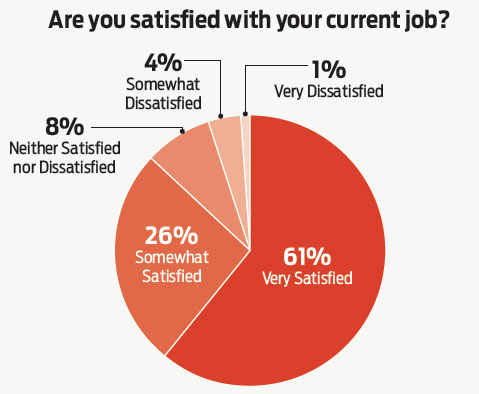
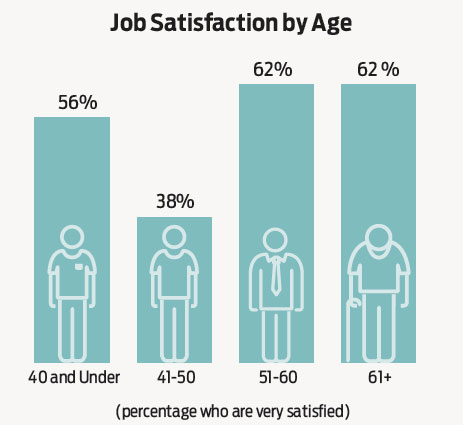
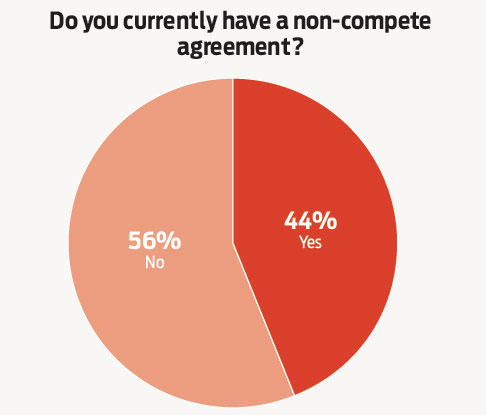
CHALLENGE: The Negotiation
Applicants’ high compensation expectations, and ability to easily compare open positions to find just what they’re looking for, makes it imperative for companies to be competitive with what they can offer.
“They can do a quick job search and see who’s hiring and what they pay,” says Carlson. “If a position is 100% commission, they say, ‘But this other company is offering a salary, a company car, benefits, training. Why would I go all commission?’”
It’s no secret the industry has struggled specifically with attracting younger salespeople to its ranks, and a major factor is that much of it is still commission-based. “They want the added stability of a salary and benefits,” says Danny Friedman, vice president of Chicago-based Added Incentives and a sales trainer. “They want compensation/benefits packages and major training programs.”
But it’s difficult for smaller companies to offer guarantees that aren’t tied to performance. Just over 10 years ago, Josh Frey, a sales trainer and founder of The Swag Coach (asi/340317) in Falls Church, VA, had 12 reps each receiving a base salary plus commission and benefits. But in 2008 the economy tanked, and Frey saw the writing on the wall.
“I had to tell everyone I couldn’t afford to pay them under that compensation plan anymore,” says Frey. “Instead, I offered a higher commission percentage but no insurance, and I would teach them how to set up their own company so they would be independent contractors and could keep their house accounts. Seven of the 12 took me up on it. The next year, we made more money than ever before.”
At the same time, it’s hard to attract new hires with commission-only plans, so companies have had to offer hybrid plans when possible. Ontario-based Ideavation (asi/229801) offers its reps a salary plus bonus depending on their sales, for example. “I think the days of straight commission, where you start with no book of business and are told ‘good luck,’ are over,” says Managing Director Scott Hulbert. “We’re also finding that the compensation they’re expecting isn’t proportional to their experience. Expectations are very high.”
Some companies are also starting to require income verification to back up an applicant’s claims. “They’ll say, ‘I made such-and-such amount at my previous job,’ and the hiring company says, ‘We need to see proof of that,’” says Green. “It inserts a bit of suspicion into the conversation from the beginning, but hiring is a big investment.”
Most reps at City Paper have a draw-based commission plan to give them some breathing room at first. “We give them time to get on their feet so they’re not sweating it those first months,” says Stephanie Friedman. “When you’re too focused on counting your sales, it’s hard to grow your business.”
Image Source lets reps choose the package they want, salary plus commission or straight commission, but they have to commit to it. “We used to be all commission and you could take it or leave it,” says Holt. “Now we let them choose their path, but there can’t be a lot of flipping back and forth. You want the added security? OK, you can have it for a lower commission rate. If they don’t have a track record of success yet, it’s nice to have a base plus. We don’t want anyone to starve.”
In addition to compensation, companies are also feeling the pressure to compete in terms of the workplace environment they offer. “It’s the Google model of company culture,” says Hulbert. Hires have come to expect fun workplaces that offer a healthy work/life balance, camaraderie and a sense of purpose. In addition, hiring managers want to know that they’re bringing on a team member who will blend well with existing employees.
Sales Managers
Most sales managers still have a direct hand in selling, but they’re also increasingly not receiving a bonus or commission based on the sales of their reps.
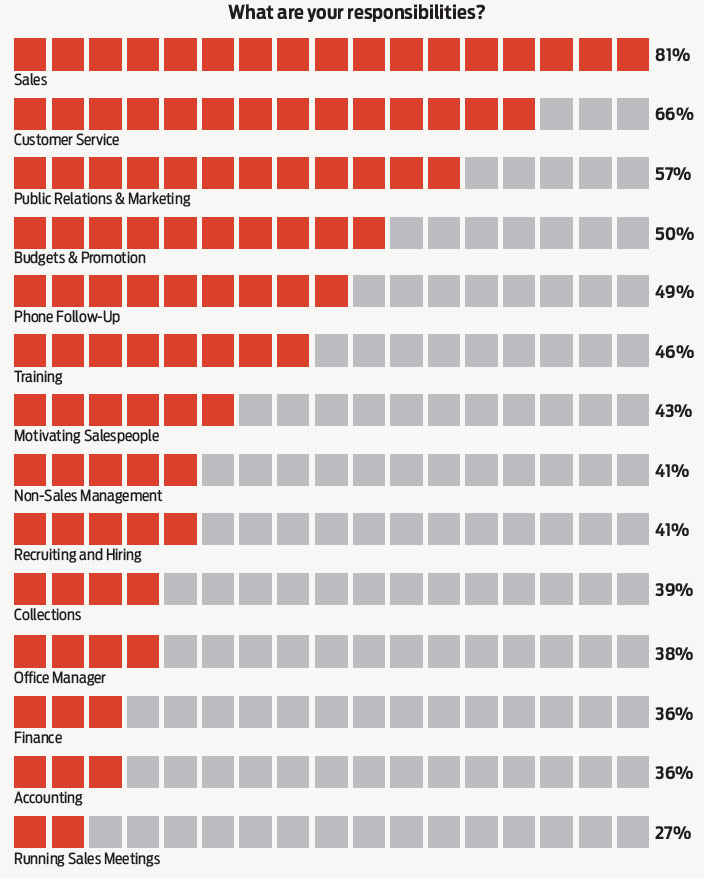
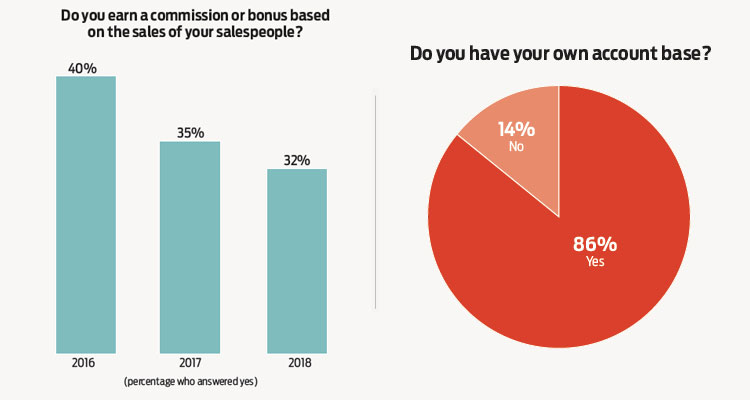
CHALLENGE: The Hand-Holding
New hires, particularly greener ones, have come to expect their new employer to invest in them with not only money, but also comprehensive training. That means a full schedule of coaching, shadowing and ride-alongs before they’re expected to actually start selling. The days of showing them their desk, handing them business cards and having them start cold-calling are effectively over.
Onboarding is certainly a time and money investment, but it’s imperative. Hulbert estimates it takes up to 10 hours per week with a minimum cost of $25,000 to $40,000 from the investment in training tools, the time other employees have to spend with the new hire and the money the new hire isn’t making yet. “It used to be, ‘Here’s your computer, good luck,’” says Hulbert. “Now there’s more hand-holding, weekly meetings, follow-up and mentoring.”
Frey offers an 11-module program, as well as online training so employees can be mobile. “They need to be trained professionally instead of being asked to wing it – it makes us all look better,” he says. “Feed them, and give them house accounts to help them start. I’m making less money because I’m handing off an account, but it gives them confidence and helps them build their book of business.”
Often in his consultations with companies, says Frey, businesses say they just don’t have the time to train and shouldn’t have to give new hires any existing business. “They expect them to hunt and kill,” says Frey. “But training keeps them motivated and focused. It gives them rhythm and confidence, and they can get more business in the long-run.” It also reduces employee turn, which is obviously beneficial after having invested considerable time and money in hiring them. “It can’t just be two weeks of ride-alongs,” says Green. “Training never really stops. If they fail, the company didn’t train them. You can’t skip it.”
At Whitestone Branding, reps get together every morning to share their wins from the day before and their current challenges, and credit colleagues for a job well done. It’s a way for everyone to be transparent and learn from each other. “We want people to stay at their job for a while,” says Sommer.
It all comes down to this: A distributorship can’t grow without committed, motivated sales reps bringing in the numbers. But in the current hiring environment, it will have to use creative methods to compete for talent and keep that talent performing for them.
“We’re competing with lots of companies in different industries for sales talent,” says Danny Friedman. Promotional products can vie with the best of them, he says, when it comes to benefits, earnings potential and employer buy-in. But new hires will have to work their way up. “If you want a great industry with the best training and no ceiling on what you can make, come work for me,” he says. “But you have to believe me.”
Sara Lavenduski is the senior editor for Advantages. Tweet: @SaraLav_ASI. Contact: slavenduski@asicentral.com